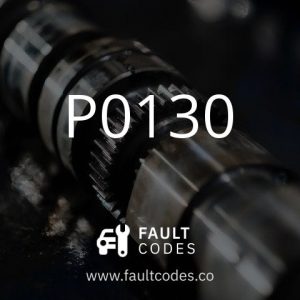P0130 Fault Code
You can find information about the P0130 fault code on this page.
We have given it a seriousness of 7/10 with 1 being the least serious and 10 being the worst.
Looking To Fix This Yourself?
By using a workshop/repair manual you could diagnose and even fix this issue yourself.
You can find a collection of free manuals containing loads of information specific to your car on our partner site.
View Workshop/Repair/Service Manuals » Long Description
Long Description
Fault code P0130 is logged when the engine control unit (ECU) has detected a malfunction with the signal from the bank 1 oxygen sensor 1.
This happens when the ECU does not pick up proper activity from the oxygen sensor in question.
An oxygen sensor is used to monitor the air-fuel ratio found in exhaust gases. When too little oxygen is detected, it signals a low voltage output to the ECU. These sensors help determine the level of emissions that are being produced by the engine.
A faulty O2 sensor can cause the engine to run improperly due to an incorrect air-fuel mixture in the combustion chambers.
Manufacturers like Fiat, Hyundai, and Suzuki are some of the most commonly searched when it comes to this fault code.
 Other Signs of This Problem
Other Signs of This Problem
There can be relatively few symptoms when it comes to a fault with the oxygen sensor, depending on the root cause of the issue.
The first and most obvious sign will be the Check Engine light being illuminated on the dashboard.
The engine may also run poorly. These can include things like lower power, reduced fuel economy, and even stalling in some instances.
It is also possible for the exhaust to emit black or white smoke depending on if the engine is running rich or lean respectively as a result of the issue.
Fault code P0130 represents a general malfunction with the oxygen sensor in question. This means it is very likely that other fault codes like P0131 to P0135 could be logged. There are also codes from P0171.
 What Could Be The Problem?
What Could Be The Problem?
Because this fault code represents a general malfunction, there are many potential causes. This makes it important to look out for additional fault codes being logged regarding this oxygen sensor.
The sensor itself is one of the most likely causes.
Damaged components in the sensor circuit can also be the cause. These can be things like damaged wiring and loose or corroded connections.
Air leaks in the vacuum can cause this error to be logged. Additionally, a fault with the mass airflow (MAF) sensor can also cause this. Exhaust leaks can also have the same effect.
Faults in the manifold absolute pressure (MAP) sensor have been known to cause this issue. If the MAP sensor is sending signals outside of the allowable range, this can affect the O2 sensor.
In some instances, the evaporative emissions control (EVAP) system can be the cause.
 Fixes
Fixes
Fixing this fault code is heavily dependent on finding the true cause of the issue. This means expert help is often required.
Because the fix can be extensive, it is important to ensure that the fault is really there. Be sure to clear the fault code and perform a road test to see if the code is logged again.
The sensor in question should be checked and replaced if it is faulty. The components in its circuit also need to be fixed if they are loose, damaged, or corroded.
Any leaks in the intake and exhaust systems need to be located and fixed.
The MAF and MAP sensors should be cleaned and checked. If they are faulty, they can be replaced.
 Seriousness
Seriousness
Fault code P0130 should be considered a moderately serious issue. In some instances, this code can result in damage to the catalytic converter, which can be an expensive fix.
It is a good idea to have this issue fixed as soon as possible.
Popular Fault Codes
These are the most popular fault codes that people are searching for.



